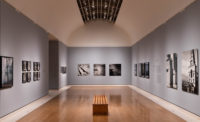Ai Weiwei, China’s most famous living artist, is not a licensed architect, but he sure acts like one: He designs buildings, creates gigantic site-specific installations, organizes art exhibitions, and makes works of art constructed like houses. And most recently, the Chinese artist/dissident/provocateur has been honored with an epoch-making retrospective at the Royal Academy of Arts in London (through December 13).
The Academy filled all 11 galleries and its outdoor courtyard with works made after 1993, the year Ai returned home to China following 12 years in the United States. The pieces include eight 20-foot-tall “trees” made from bits of dead ones from China, a modernist chandelier comprised of crystal-festooned stacks of gleaming bicycles, and six room-sized, iron-framed boxes containing dioramas at a half-life-size scale depicting the time he spent incarcerated.
One particularly moving exhibit stands out: a gallery with hundreds of rusted steel reinforcement bars, laid out like waves across the floor.
Ai visited the wreckage of Sichuan, China, after the 2008 earthquake and was devastated about the thousands of children who were killed in schools that collapsed because of shoddy construction. In a public program the night before the opening of the show, Ai recalled visiting the ruins. “There was dust in the air. Physically, I was shaking. It was a strange experience,” he said.
He and his team salvaged 150 tons of mangled steel from the wreckage, transported it to his studio in Beijing, and pounded it by hand into Straight, 2008-2012—a 90-ton floor-based sculpture made up of hundreds of stacked steel rods from Sichuan.
“After I was released,” Ai said, “the first time I approached my studio I heard the sounds of people straightening the metal rods. It never stopped. It took years. Each piece took 200 blows. I think the metal has meaning, and not only as evidence. The material started to speak.”
The gallery walls surrounding the rods display a related work of art that looks like graphic wallpaper: Names of Student Earthquake Victims Found by the Citizens’ Investigation (2008-2011), is composed of long printed lists with the names of the children, in Chinese and English, their gender, and birth date.
Ai has no formal architecture degree. After he returned to China, he moved to a Beijing neighborhood called Caochangdi and built his first architectural project, a studio house. (“When I finished building my house, I learned that I was an architect,” he said at the time.) He went on to build several other studios there in what would become a thriving arts district.
He also established FAKE Design, Ltd. an architectural studio. The name references Marcel Duchamp, whose work Ai first admired in Manhattan. Duchamp, Ai said, is “the most, if not the only, influential figure in my so-called art practice.”
Although Ai has completed some 70 architectural projects over the years, he closed FAKE in 2012 because of the complexities of working with construction companies and government officials.
Ai has famously collaborated with other architects, most notably Herzog & de Meuron. He worked with the Swiss firm on the design of the “Bird’s Nest” stadium for the 2008 Beijing Olympics, the 2012 Serpentine Pavilion in London’s Kensington Park, and served as a curator for “ORDOS 100,” an unrealized project in which the artist invited 100 young international architectural firms to design houses for the Mongolian steppes.
But architecture has not been an easy part of Ai’s life. In 2010, the Chinese government invited Ai to build a large art studio in Shanghai—planned to be the cornerstone of a proposed new arts district. He did, only to be told that, because of non-compliance with local building regulations, the vast brick complex would be demolished. He was placed under house arrest in order to keep him from attending a party he organized mocking the demolition. (Some 800 people gathered for a river crab feast, celebrating the completion—and imminent demise—of the building. In Chinese, the word for river crab sounds like for the word “harmony,” a government phase used to justify censorship.)
“For the hardliners within the party apparatus, his architecture had become a symbol of the person,” writes Royal Academy of Arts curator Tim Harlow in the exhibition catalog. “The destruction of the studio signaled that the room for maneuver that the artist had been granted … could be revoked at any moment without legal justification.”
Two works allude to this event: He Xie (2011), a pile of 3,000 red porcelain crabs stacked in one corner of a gallery; and Souvenir from Shanghai (2012), an installation of red bricks and cement salvaged from the rubble of his demolished studio, meticulously fitted into an elaborately carved antique timber bed from the Qing dynasty. The sculpture is almost the size of a small house.
Ai says he is done with building—but maybe he isn’t. His friend, the London architect Daniel Rosbottom, quotes him at length in his catalog essay. Asked about the practice of architecture, Ai said, “I actually never really separate those things: art, architecture, design, or even curating. To me they are just different angles or different ways to talk about the same things.”








Post a comment to this article
Report Abusive Comment